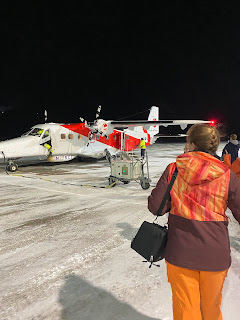Orientation day
The first day of any research trip is jam-packed, and our first day in Ny-Ålesund, Svalbard, was no different. We arrived at the remote research station on a 14-seat airplane powered by two external propellers (a Dornier 228, for any aviation nerds out there). I originally thought we might be the only ones on the plane, but as it turns out, another research group was headed up to Ny-Ålesund the same day. It was actually nice to get to know them as we waited - we'll be seeing a lot of each other on station.
The flight from Longyearbyen to Ny-Ålesund is part of the Arctic experience, so I have to describe it to you. First, you arrive at Longyearbyen airport about 30 minutes before your flight. When there are 9 passengers, there's really no rush to come hours in advance. You enter through a side door in a building adjacent to the main terminal and find yourself in an airplane hangar. There's no security check because this is a private flight. All your luggage gets weighed, and everything - even backpacks - are handed off to the crew. There are no overhead bins, and no luggage can travel under a seat on this tiny aircraft. All boxes, suitcase, and handbags are ratchet-strapped down at the back of the plane, and the crew do some quick math to make sure everything is properly balanced.
 |
| Walking out to the plane. Photo by Kharis Schrage. |
A set of large garage doors open, and the plane rolls out into the snow. Passengers enter the plane outside via a set of stairs and choose a seat - there's only one on each side of a center aisle, so everyone gets a window. As you take off, you put in ear plugs to drown out the noise of the engines whirring beside you. The cabin isn't pressurized, so you can feel your ears popping as you climb. I've only ever done this flight in pitch black polar night, so I actually can't tell you what it looks like outside. I imagine the views in daylight would be breathtaking. Every once in a while, you will see a white sheen of snow atop a mountain emerge from the darkness. After just 20 short minutes, you touch down in Ny-Ålesund. With no roads between Longyearbyen and Ny-Ålesund, the plane is the most efficient option to hop over the mountains and get to the research station.
Ny-Ålesund staff pick you up at the airport and take you on a shuttle into town. The main building, called the Service Building, houses the reception office, kitchen, mess hall, and laundry. You receive your keys, locate your dormitory, and then come back for an afternoon of one orientation meeting after another.
Life in Ny-Ålesund is very unique. The entire town is dedicated to research and run by one company, called Kings Bay. There is no cell reception or wifi because the frequencies used for wireless communication interfere with radio telescopes used by the Norwegian Mapping Authority. Internet is available by ethernet cable only. There are 10 permanent research stations belonging to 11 different countries in Ny-Ålesund, and it's not uncommon to have 20 nationalities represented on station at a given time. You might think this diversity would lead to a scattered social life, but in fact, Ny-Ålesund is a very close community. With only about 40 people at the station in the winter, there's a strong sense that we need each other.
After finishing all our orientations, Kharis and I located our boxes of equipment and started setting up the lab. It was a very productive first day in Ny-Ålesund!
Comments
Post a Comment